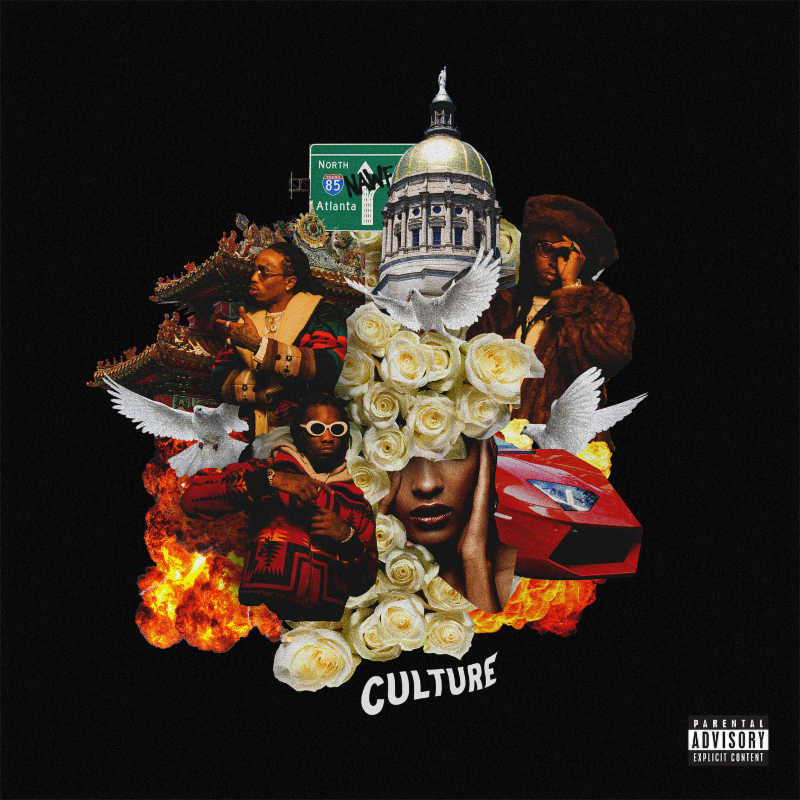When Atlanta’s Migos released “Versace” in 2013–and in the following year, in which the trio’s unmistakable triplet raps began to rule hip-hop on a global scale–it was hard to predict that their most commercially successful moment would come years later. At a glance, they had all the trappings of a flame destined to burn quickly and brightly, with their particular charm that could only endure via anthemic, in-the-moment repetition. By mid-2015, with post-“Versace” hits “Fight Night” and “Handsome & Wealthy” in the rearview, it seemed that Migos might have hit a wall. None of the songs on their delayed studio debut, Yung Rich Nation, broke the Hot 100, even as the group’s Takeoff rapped that the next thing they dropped would “have everybody screaming ‘pipe it up,'” on the album single of the same name.
But later that year came “Look at my Dab,” a song about their hometown dance craze that brought them back on the charts. Now, the trio has ascended to astronomical heights thanks to an even more potent meme, one that has more to do with their actual music. The ubiquitous, sticky first two lines of “Bad and Boujee” have provided fodder for infinite parodies over the past few months, as well as the standard dance videos. Today, as the group’s long-delayed second LP Culture materializes, “Boujee” is the No. 1 single in the United States. “Versace,” though unforgettable as the group’s breakout hit, peaked at No. 99.
Despite the twisted path the three Migos’ careers have followed, it would be easy to draw a connection between the two songs: When Offset raps “smoking on cookie in the…” and “cookin’ up dope in the…” on “Bad and Boujee,” he uses that same flow, the one which made the “Versace” chorus such a sensation. Then again, it’s also the pattern that grounds something like 90% of Migos songs. It’s fair to wonder what, exactly, “Bad and Boujee” has that “Pipe it Up” or “Handsome and Wealthy”—or even lesser-known tracks like “Pronto” and “Cocoon”—didn’t. Is the key to the song’s success really in the music, or is it thanks to the ravenous meme opportunists that pinpointed the natural comic timing in its first two lines, and ran with it from there?
In other words, it’s hard to imagine what a modern-day Migos would sound like detached from the viral trappings that cast such a long shadow over their careers. Nonetheless, there are plenty of moments on Culture when the group’s larger-than-life aura manifests itself in sound alone. Quavo maintains his remarkable track record with clever turns of phrase, which goes beyond just the funny cocaine-as-white-celebrity euphemisms (“Andy Milonakis” is a new addition), of which he may be rap’s current champion. The group’s dotted-and-dashed raps move at a typically rapid clip, their slick, deadpan delivery almost downplaying plenty of flashy couplets (“I got M’s on my mind / I got boulders in my time”) and punchlines (“Put a model bitch on coca / Told her read between the lines”) that would be the main events in verses by lesser rappers.
One thing Migos rarely do—which predecessors and contemporaries like Young Thug, Gucci Mane, and Future have accomplished countless times over—is elevate a mediocre beat with unexpected new ideas. The key to Culture’s best non-singles is an alchemical reaction that takes place when evocative production rubs up against their clipped, triple-time hooks in the most appealing possible way. On “T-Shirt,” the album’s second best single, veteran ATL beat architects Nard & B’s bass mark their textbook kick-drum patterns with a foreboding, creeping bass melody which accentuates the emphasis of the rappers’ flows–(“Whoa kemosabe, chopper aimin’ at your noggin”)–while a haze of backward noises and drowned, throaty wails float in the background. The song embodies everything that can make trap music stylish and addictive, even when it offers no real surprises. Migos, at this point, have laid the framework to make the Southern-rap equivalent of a major-label pop album, with access to the most desirable collaborators, and holding the patents to a host of market-tested tricks.
As the sudden, if not random, success of “Bad and Boujee” proves, there’s also little incentive to reinvent the wheel. Insofar as Culture illustrates stylistic progress for Migos, it is in its welcome brevity–12 full tracks compared to the group’s customary near-20–and its neat-freak focus on chart-ready material (“Get Right Witcha” and the Gucci Mane-featuring “Slippery,” particularly, feel like possible hits). There are no atypical narrative experiments in the vein of Yung Rich Nation tracks like “Migos Origin” or the West Coast gangsta rap throwback “Highway 85,” which was the only time one might have felt compelled to compare Takeoff to 2Pac. The sprawling technical workouts that make up much of the 2014 mixtape Rich Nigga Timeline are also nowhere to be found. Culture is the memeable, archetypal Migos, distilled and well-sanded. The album only seems to tire of being serviceable and precise in its final act, slumping into the oddly bloated, Travis-Scott-assisted ballad “Kelly Price” (“She gon’ eat the molly like it’s rice… I’ma make her sing like Kelly Price”). The fade-out sequencing seems fitting for the album-as-playlist era, cognizant of the fact that many listeners may never make it past the 30-minute mark.
That might be fine, though. Nowadays, Migos can trend simply off a radio freestyle. In the past week, it’s happened twice: once when they spontaneously constructed a song based on a children’s book, and once because Laurence Fishburne showed up to listen. In these appearances, they ease into their stop-and-start riffing after first nailing down the catchy hook (“Llama llama red pajama,” in the first instance). It borders on being familiar to the point of inadvertent parody, but also arresting and strangely comfortable. Listening to a good Migos song is a satisfying and invariable sensation, like chugging a glass full of Brita water in 90-degree heat or turning on full-spectrum light on a dark winter night. If you gauge artistic success by innovation, you can just filter the best of Culture, a very decent group of Migos songs, into a playlist. But if you appreciate Migos and the sound they ushered into contemporary rap as being one of the genre’s most basic, essential natural resources, it will be easier to let the whole album–a drama of perseverance–ride out.





